
How to shop for healthy groceries
Paul Finkelstein has seen hundreds of students come through his culinary arts program at Stratford Northwestern Secondary School in Stratford, Ont. Many more students have eaten in his healthy alternative Screaming Avocado café (insider tip: Justin Bieber was a regular).
“I always hope they learn healthy tips,” says Fink. “Cooking from scratch every day gives them tools to change how they eat.”
But what about grocery shopping? “Most kids at high-school age have no idea of how to shop for healthy food,” Fink says. So he recently decided to take a group from his culinary club on a shopping excursion. I joined him that sunny morning with his group consisting of four teens, age 15 to 18.
“These kids are pretty savvy and health conscious compared with kids in the school who aren’t taking the culinary arts class,” says Fink, as we walk into the store. Even so, as I would observe that day, though they thought they and their families were eating and shopping relatively healthfully, they soon realized they were wrong.
Stephanie Roth, 17, related after the trip was over, “I was shocked when I looked at the ingredients in some of the things I buy. I needed whipped cream and reached for the canned stuff. The first and second ingredients on the label were water and sugar! I’d rather whip real cream myself.”
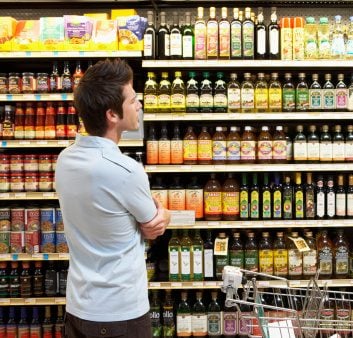
Navigating the grocery store
Standing at the entrance, Fink asks what products the kids see. Their answer: pop, cookies, chips. “Walk past everything at the front,” Fink advises. “These are called ‘loss leaders,’ which is stuff that’s on sale in the flyer to bring customers in. Most of it is void of any nutrients.”
You find healthier stuff at the periphery of the store, explains Fink. But he begins by pushing the cart toward the inner aisles. “You want to start with canned-food staples, which weigh more, so that your produce sits on top of them rather than the other way around. And you want to save dairy, meats and frozen foods until last, since they need to stay cold.”
There are pantry staples that should be in everyone’s kitchen, “things like canned tomatoes, whole-grain pastas, brown rice, and legumes such as chickpeas or lentils,” Fink tells them. “Your kitchen should be stocked with healthy, non-perishable items you can use for quick meals. Buy low-sodium varieties of canned products and rinse them before you cook with them.”
Saskatoon registered dietitian Noelle Tourney agrees: “There’s great stuff in the inner aisles. Brown or wild rice; quinoa; barley; high-fibre cereals; nuts; low-sodium canned tuna, salmon and vegetables. And go for 100 percent whole-wheat pasta: It hasn’t been stripped of the bran and germ, and contains more vitamins, minerals and fibre.”
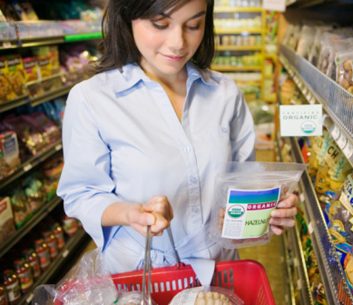
What to look for on the food labels
“Everyone should be label savvy,” Fink explains to the kids as they stand in the peanut-butter aisle picking up products and inspecting them. “I look for foods with no more than five ingredients.”
Many kids like peanut butter, and these students are no different. But Tayler Trachsel, 15, and Roth are surprised to learn the one their parents buy has lots of salt and sugar added. “Those are two things kids love, and that keep them coming back for more,” Fink tells them. Both agree they are switching to natural peanut butter.
When looking at nutritional information on the package, do it with a discerning eye, Tourney advises: “There are things we want lots of, such as fibre, vitamins and minerals. And we need to limit saturated fat, trans fat, sodium and added sugar.” Look at the Daily Value percentage (%DV) on the label, which can help you figure out and compare the nutrient profile of various foods. A %DV less than five is considered “a little” of that nutrient, and a %DV over 15 is considered “a lot.”
As far as salt and sugar are concerned, “sodium goes hand in hand with convenience-frozen dinners, canned and dried soups, and deli meats,” says Tourney. Salt is added for taste, and as a preservative.
Sugar is a bit trickier, because labels don’t differentiate between added sugar and naturally occurring sugar, she says. “Added sugar comes in many different forms: glucose, glucose-fructose, dextrose, fruit juice concentrate, high-fructose corn syrup, golden syrup, malt syrup, honey, molasses, barley malt, agave nectar, evaporated cane juice extract-and there are even more.”
Fink had his own teaching moment regarding added sugar: “There’s cane syrup in this chicken stock!” he exclaims to the kids in disbelief as he reads the package label. “Why?!”
Trachsel, an avid hockey player, offers a suggestion: “Make your own,” he says, with a shrug and a grin. Clearly, a few things have sunk in.
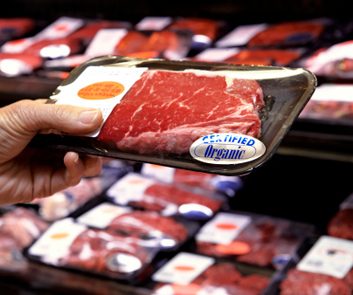
Choosing meat, eggs and dairy
Go for lean meats, and buy organic or free-range if you can afford it. Boost the flavour of lean meats with rubs and marinades. “Free-range means they have had room to move around, as opposed to factory animals kept in closed conditions. Organic means they haven’t been treated with antibiotics or hormones,” explains Fink.
Everyone wants a quick burger sometimes, but Fink notes that most boxed frozen burgers are full of saturated fat and sodium. “Take the time to make a batch of your own from scratch and put them in the freezer,” he says.
For eggs, brown or white varieties have virtually the same nutrients. The classification “Omega 3” indicates that the hens’ feed contained flaxseed.
What about bacon to go along with eggs? “I love turkey bacon,” says Hawkins. “Full of salt,” Fink says, flipping over a package and reading the ingredients. “Salt is added in different forms three times. You might as well just have regular bacon.” There are now low-sodium varieties.
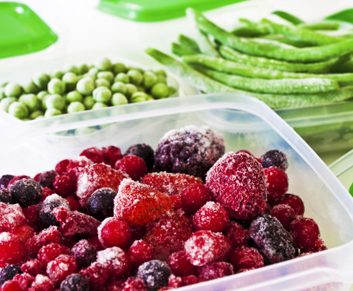
Not all frozen food is bad
Don’t race past the frozen-food section thinking that it’s filled with danger: Even though it’s home to ice cream and convenience meals, there are healthy foods here, too. “Frozen fruit and vegetables are a great alternative to fresh,” says Fink. “They’re flash-frozen at their peak so they retain their nutrients,” says Fink. Looking for frozen fries? He suggests the ones that are low in sodium and fat. And buy frozen fish and shrimp, but look at sodium levels, and avoid those with breading.
As for frozen pizzas, says Fink, picking one out from the freezer’s shelf, “Yes, they are quick. But look: One sixth of this pizza contains 40 percent of your daily sodium, and 20 percent of your fat! How many of you would eat just one sixth of this pizza?” The kids don’t even need to answer.
“Instead, buy fresh or frozen whole-wheat crusts or dough, and add your own healthy toppings. That way, you control the amount of cheese and meats you use.”

Get the family on board
Michelle Robinson, 19, says it’s hard for her family to eat healthfully all the time, because everyone works and has different schedules. “My mom cooks for a living, so when she’s off she doesn’t want to cook. I do it.” She realizes her mom isn’t reading labels, and says she plans to talk to her about it when she gets home.
Katelyn Hawkins, 17, helps out with the cooking, but says, “My younger brothers and sister won’t eat what my mom, dad and I eat. My siblings basically eat frozen burgers, nuggets…that sort of thing.”
How do you solve the picky eater problem-and avoid shopping for and cooking two meals? “Engage your kid by switching it up,” Fink suggests. Make healthier versions of chicken fingers, and get them to try new flavours, jazzing the dish up with dipping sauces.
Fink says his youngest child, Quinn, 9, is picky. “Most of us have flavours and textures we don’t like, no matter how many times we try something. But persistent nudging of kids can backfire, and make them become picky eaters. With Quinn, we encourage him to just try different tastes.”
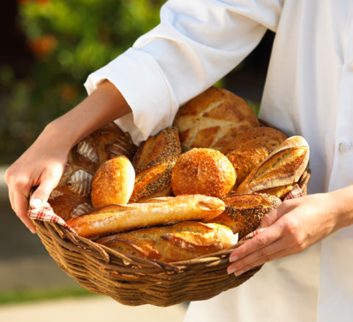
Shopping the bread aisle
“Look at this: Two tortillas have 21 percent of your daily sodium,” Fink says, as we hit the bread section. “And for them to be this pliable, there has to be oil in them.” Trachsel grimaces, and says he is more of a bagel man. “There are 250 calories in one bagel,” Fink says, tossing the package at him. “Pumped with sugar.”
Although there is sugar in all bread, look at the label “and try to avoid breads that have sugar added more than once in its various forms,” says Fink, a firm believer in buying multi-grain from the bakery department, which usually has the fewest ingredients.
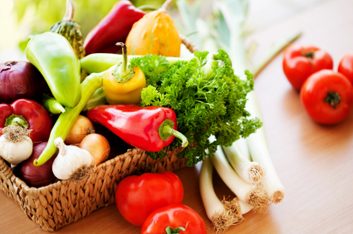
Picking fruit and veggies
“Colour is the most important thing,” says Fink, picking up a head of broccoli. “Eating fresh vegetables in different colours provides the body with the most important nutrients and antioxidants. The brighter, the better. It’s also exciting to the palate and makes dishes more visually appealing.” (Tourney agrees with him.)
But how do you choose the healthiest, freshest ones? “Veggies and fruit should be firm and without bruises. But also, don’t be hesitant to have some of these in your fridge,” he says, grabbing a bag of pre-chopped veggies. “They are great for quick meals, either chopped up as coleslaw or added to a stir-fry. It would be great if you had the time to chop up the cabbage, carrots and broccoli yourself, but if you don’t, having this stuff on hand can make for a quick, healthy meal.”

What a healthy grocery cart looks like
As they look at their cart before checking out, the kids are asked to figure out what percentage each food group makes up. They examine the cart: Grains and breads, roughly 20 percent; dairy products, about 10 percent; meat and fish, 10 percent; and oils and other staples, 10 percent. The rest, nearly 50 percent of the cart, has come from the produce section of the grocery store, which roughly follows the proportions suggested by Canada’s Food Guide.
“When you go shopping,” Fink asks the kids after they walk out of the store, “is this how your cart usually looks?” The kids tell him they are going to go home to talk with their parents.
Class dismissed.
Related:
• 9 ways to save money on groceries
• How to stock a healthy pantry
• The truth about food labels
